Sept 2-4, 2011
Over the Labour Day long weekend, Nick Elson and I climbed the Viennese-Clarke Traverse and the Tuning Fork on Bardean Peak. This was two and a half days of travelling in unfamiliar terrain, covering a significant amount of elevation and distance over bits of logging road, steep forest, alpine ridges, rambly meadows, glacier slabs, steep face climbing, bushwacking and even a bear encounter. The Chehalis Range consists of a group of rugged granitic peaks located north of Chilliwack, BC, between Harrison Lake and Stave Lake. This area has held my interest for a long time, but access always seemed difficult. With news of renewed access to this area, I started to think more of getting into this area for a few days. It only takes a quick browse through Alpine Select to realize that a significant number of the technical routes highlighted there are located on a handful of peaks here.
A quick email to Nick sparked his interest and he replied with emails containing highly ambitious plans. I’m not a rockstar climber like Nick and his other climbing partners, so I suggested that we try the least ambitious of the plans. It’s easy to dream big when you’re heading into a new area, unfamiliar with the scale and length of the approaches and only fuelled by a desire to tick off the big classics.
We drove up the Harrison West FSR and onto the Mystery Creek FSR on Friday evening to give ourselves a head start the next day. The only problem was Nick’s car, which didn’t have functioning headlights. Everything was going well on the logging road, until we finally caught our first glimpse of the peaks. Moments later, with both of us hunched over the steering wheel and dashboard and distracted, the car collided with a rock. Fortunately the damage was only cosmetic and we continued by the dim glow of the hazard lights to our parking spot.
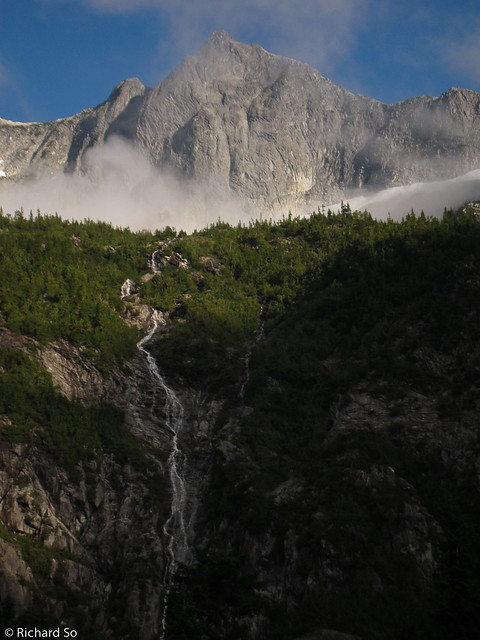
The South Face of Viennese Peak poking out through the thin clouds
The next morning, we followed our directions to the Statlu Lake trailhead and continued up the pleasant trail to Statlu Lake. Low clouds hung above the lake, but in the distance we caught our first glance of Mount Bardean, an impressive chunk of coastal granite. The forecast called for clouds clearing by noon. With that in mind, we kept an easy pace from here to Upper Statlu Lake and upwards in hopes of clear weather when we reached the alpine. We reached the col east of Peak 6500 four and a half aways after leaving the cars. We continued up and over Peak 6500 and started scrambling up the east ridge of Vienesse Peak. An exposed section between the summit required the rope and the lingering clouds added to the ethereal atmosphere. We missed our cloud window on the summit and made one rappel off the southwest face to gain an exposed traverse on somewhat loose holds to regain the easy ridge crest. From here, we continued the ridge rambling up and over Recourse Peak. The incredible clean upper slabs of Derektissima beckoned below. Years ago and still new to the world of climbing, my good friend Boris suggested that we climb this remote eighteen pitch route. I’m glad we played Halo instead that weekend instead of getting ourselves into a likely epic.
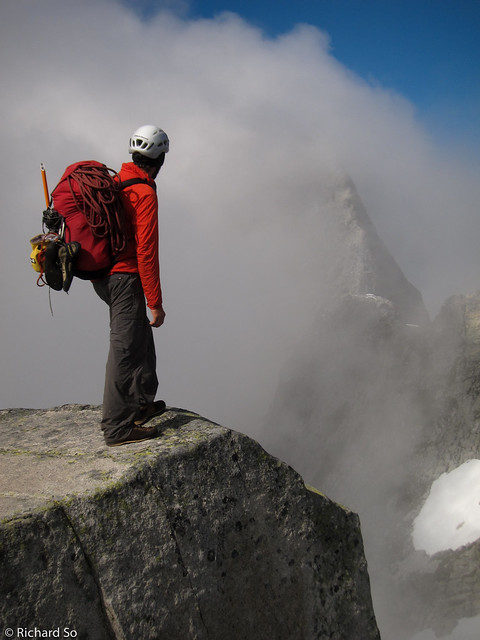
Nick looking over towards the east ridge of Viennese Peak, which came in and out of the clouds
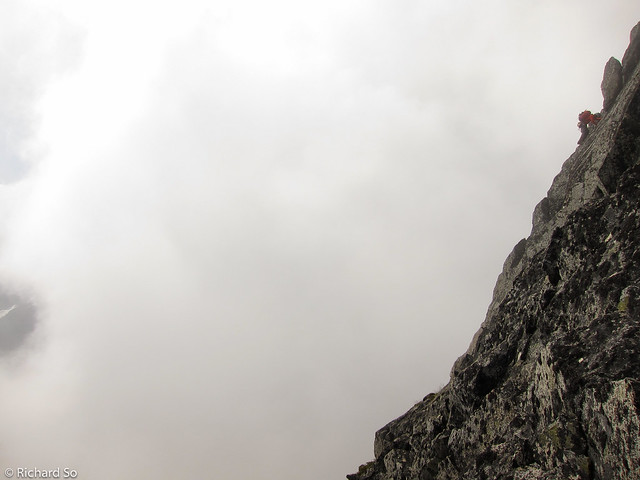
The clouds added to the exposure of this pitch which Nick lead to the summit of Viennese
The rugged glaciated north side of Mount Clarke 
Granite and Fog
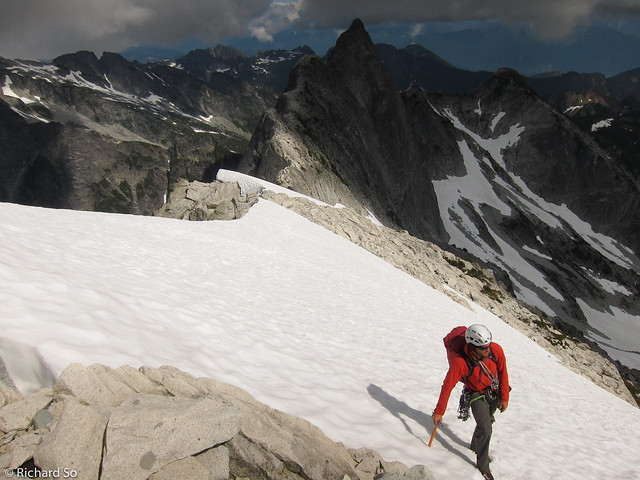
Nick on the way up to Recourse Peak
The next section of technical climbing was the east ridge of Mount Clarke. From a far, the ridge was uninviting, steep with what looked like precariously placed blocks stacked onto top of the ridge. This turned out to hold the best ridge of the Viennese-Clarke traverse, with a number of face cracks to climb along. We reached the summit after a few pitches and continued rambling along the long summit ridge. We descended the northwest ridge and got a better view of our planned route for the next day, the North Ridge of Clarke. What we saw didn’t look promising. A kilometre away and several hundred metres below, we could only see what looked like wide crevasses and a large moat barring easy access to the toe of the ridge. Under equipped with only approach shoes and crampons and without a means to protect ourselves on the broken up maze of snow and ice, we bailed on that route. We continued rambling along meadows, snow patches and glacial slaWebs in the fading evening sun towards our bivy spot below Mount Ratney to conclude our fourteen hour day.
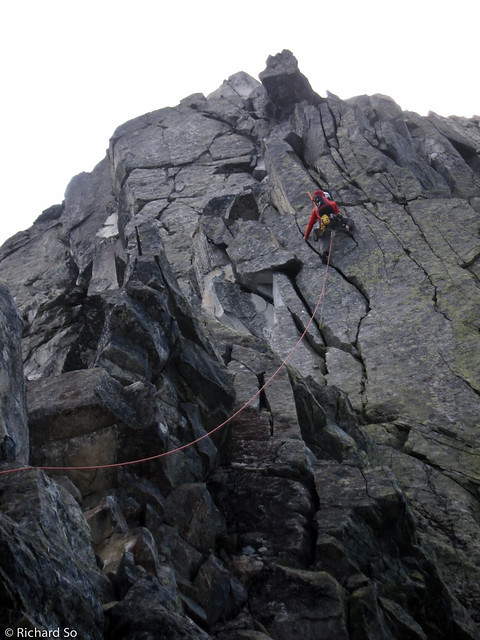
Good climbing on the east ridge of Mount Clarke
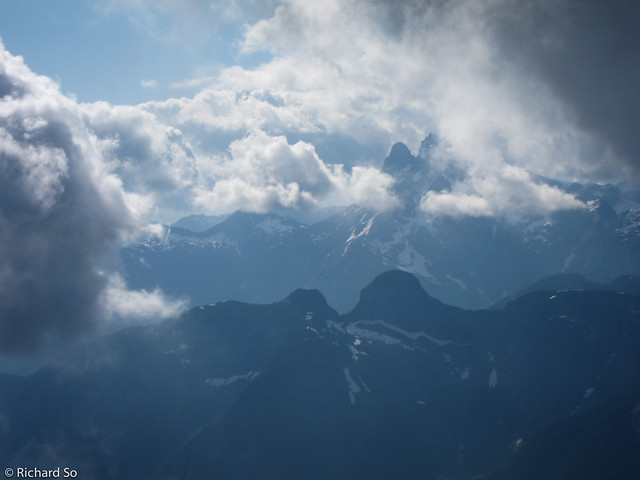
Judge Howay hovering out of the clouds
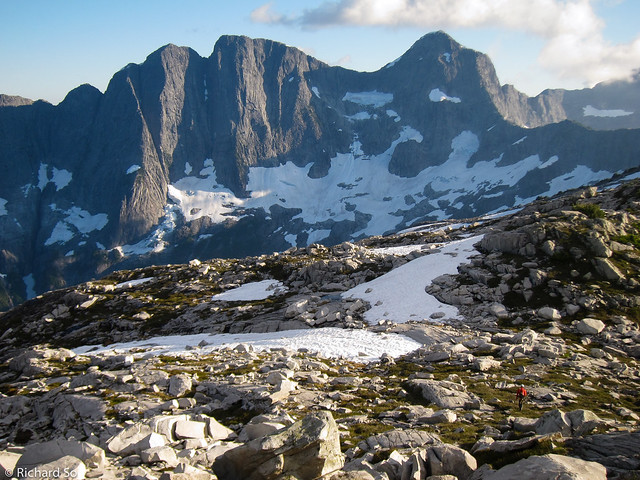
Nick on our evening stroll towards our bivy site below Bardean and Ratney.

Nick reflecting on a great day in the mountains.
The next morning, we cramponed across frozen snow to the base of the Tuning Fork on the north face of Mount Bardean. During the trek the evening before, this impressive face dominated the view. The Tuning Fork fork is reputed as one of the great classic alpine climbs of southwestern British Columbia. We were both hoping that the climbing on the lower buttress would go by quickly. Instead, it turned out into a vertical grovel up bushy corners, battling wide cracks and rope drag for three pitches. We were only able to simu-climb a short section of 3rd class terrain before the difficulties increased again. From here, we looked up onto the wide and blank wall, somewhat confused the myriad of possibilities up here. The only guiding hint was to aim for a “large, obvious left-facing dihedral which is capped by a prominent roof which juts out leftward.” This wasn’t quite so obvious to get to. Nick and I climbed a few tough and uncertain pitches between I finally gained the dihedral. Even so, while hanging out and the top of the dihedral and belaying Nick up, I wasn’t sure if the traverse line out left was the one described in the guidebook. Protection was challenging up here due to the compact nature of the rock. At the end of one long pitch over easy terrain below the summit, I was only able to build a marginal anchor of a blue metolius and another nut. It was a relief when Nick arrived at the belay and was able to beef up my anchor with another cam. The final pitch to the summit proved to be one of the more challenging pitches. From my belay, Nick tried two corners that proved to be too difficult before continuing up more steep unprotected climbing before another tenuous traverse to gain easier terrain. As I made that traverse on top rope, I tried not to think of what might happen if I fell and slammed into the overhanging corner below. I think we could have found easier terrain further to the right though.
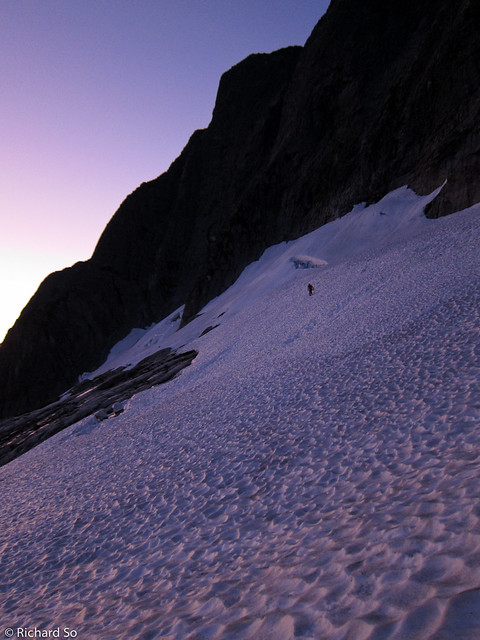
Early morning cramponing across snow slopes to reach the toe of the Tuning Fork 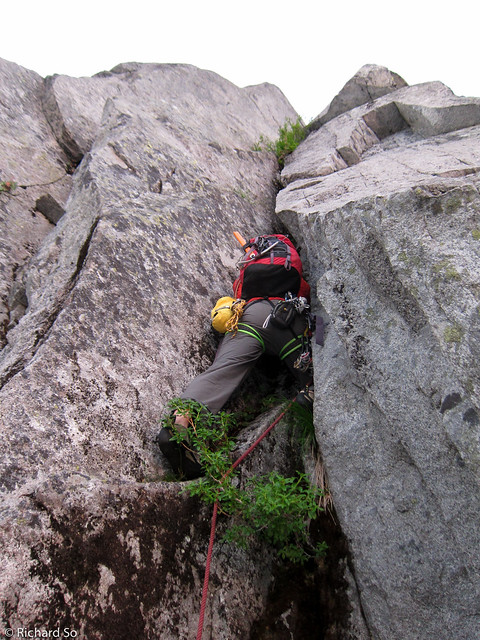
Nick leading the first burly pitch off the ground. This pitch was followed by vertical bushwacking.

Nick leading some difficult and uncertain terrain in the middle of the Tuning Fork
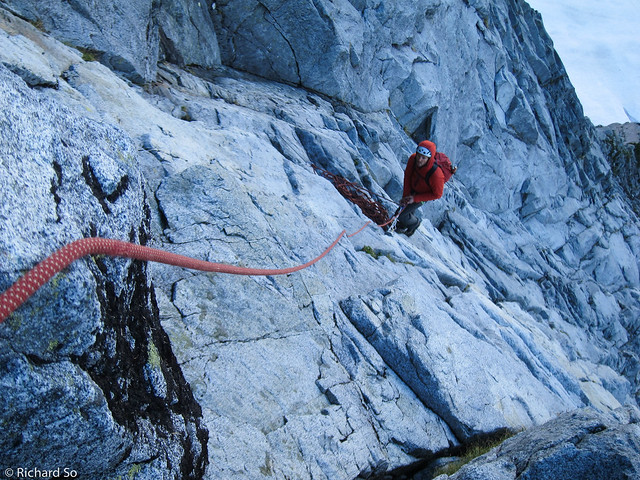
Protection was sparse. At least the rock was good here.
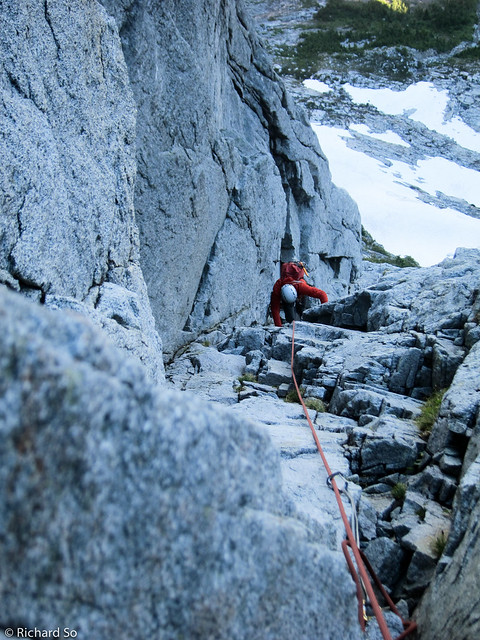
Nick climbing up into the “obvious dihedral.” It’s not entirely obvious from below.

Nick traversing out into the unknown.
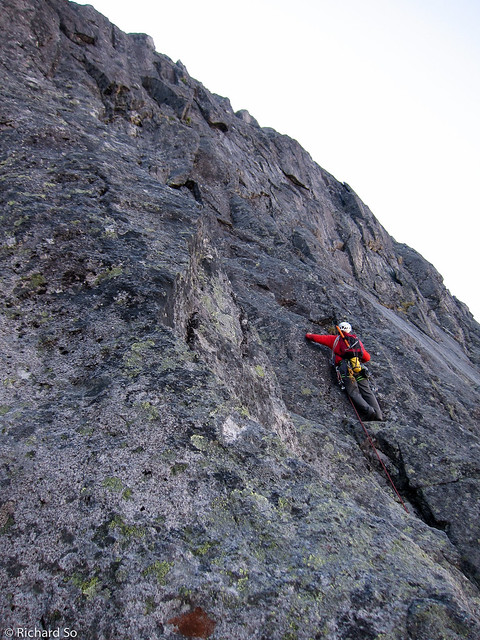
Nick leading the final pitch to the summit.
The descent off Mount Bardean is non-trivial. We still had to scramble to the summit of Ratney Peak. It was pretty cool to be up here though, with great views of some impressive peaks such as Judge Howay and Robie Reid. From the top of Ratney Peak, we made several rappels down it’s north ridge. The guidebook describes the option of one rappel and then either “slabby downclimbing or a few more rappels” but we were far more comfortable making the rappels instead. once the ridge levelled out, we rappelled down and onto what looked like the best spur off the ridge that would get us back to the bivy site. Again, more rappels were required, draining out our limited supply of webbing and cordalettes. In hindsight, the next spur along the ridge might have only required one rappel followed by more downclimbing. We plodded back to our bivy site, feeling more exhausted than what we anticipated. We looked across at our next planned objective, the Hidden Pillar and contemplated our options. It didn’t take long for the two of us, both masters of coming up with excuses, to reason that we were under equipped with this route too, lacking pitons and anchor material. It took us about eight hours to climb the route and another four hours to descend.

Nick and I on the summit of Ratney Peak.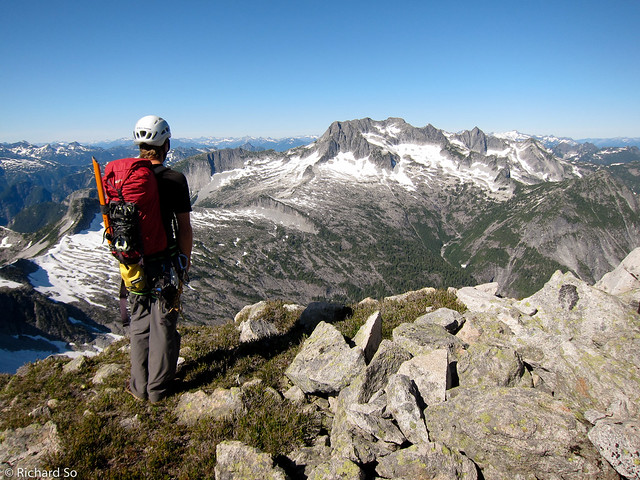
A view of the Clarke group.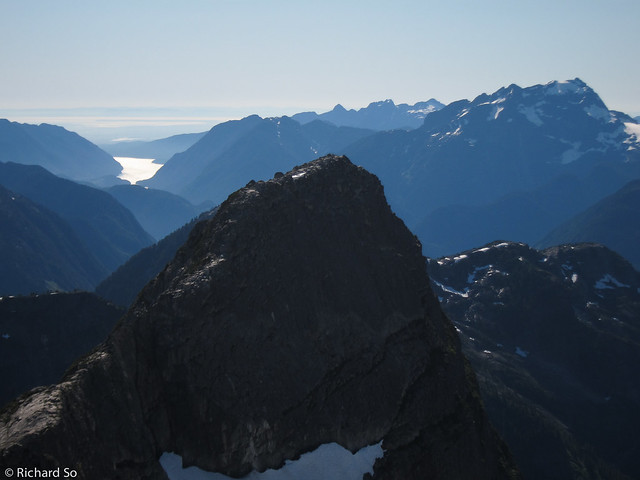
The northeast face of Stonerabbit Peak, and Robie Reid in the background.

Finally back on solid ground after many unexpected rappels.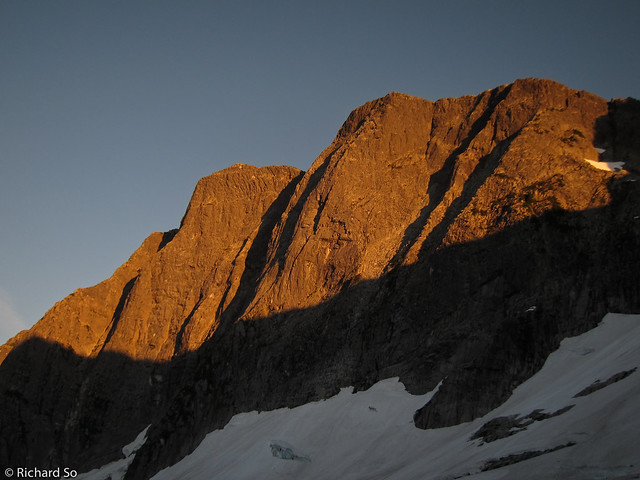
Evening alpenglow on Mount Bardean
The next morning, we wasted no time traversing the snow slopes and running across a ticking time bomb of seracs. It wasn’t obvious where the route goes, but we bushwhacked along a forested ridge west of steep outwash couloir. Many years ago, Jeremy Frimer had put in some trailwork here, but the only a few trimmed branches remained as evidence. So much for minimal bushwacking. We dropped down into the valley bottom and chose to walk and wade along the Chehalis River to reach Statlu Lake. The alternative were a series of heavily slide-aldered rockslides between bands of dense timber on the south side of the river. It was a pleasant stroll along the river, cooling our heels in the crystal clear water. The only other signs of life that we saw on this weekend was one bear, two other hikers and a dog that tried to attack Nick (I think the dog thought Nick was a bear due to his scraggly facial hair) and one fisherman who had flown in.
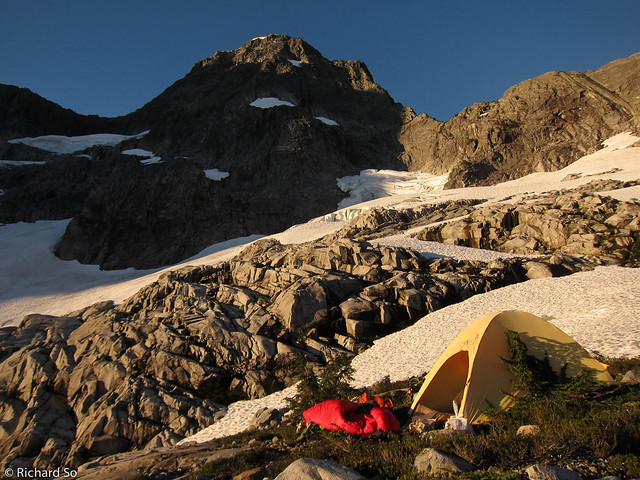
Our bivy site below Ratney Peak. Granite slabs and running water made this spot quite memorable.
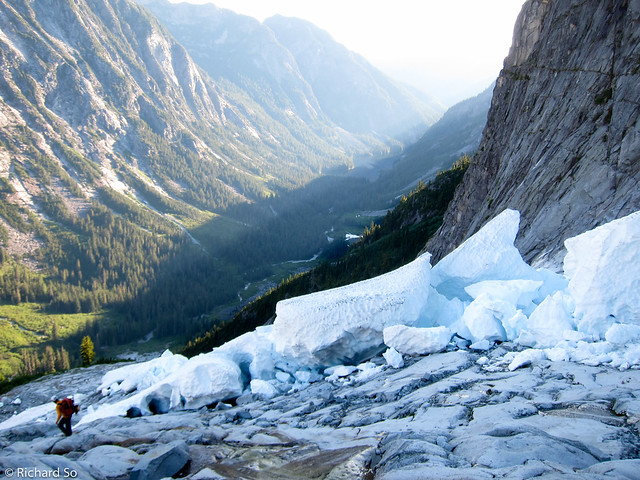
Objective hazard on the way out.
In summary, the Chehalis is a pretty cool place that doesn’t see a lot of traffic, with plenty of rock to wet your appetite. The Viennese-Clarke traverse is highly recommended. It would either be a very strenuous day trip, a two day trip or a relaxed three day trip. I think the best option is to drive up the night before, carry light bivy gear and climb the Viennese-Clarke traverse, possibly bivying on either Recourse or Clarke to catch an amazing sunset. And then complete the traverse the next day and hike out. Fun!
More Photos
Nick’s Excellent Trip Report
Current Access Information into Statlu Lake
Inspiring Supertopo Thread about the Chehalis climbing history
Freaking sweet dude. I've wanted to go there for a while too. nicely done. grrr knee.
Thanks Alex! We'll have to go in there next summer, there are suppose to be some great south facing cracks on Grainger that I want to check out!
[…] left. The route becomes straightforward by this stage. The Chehalis peaks to the east. Check out my adventure with Nick Elson in the Chehalis Range where we climbed the Vienesse-Clarke Traverse, and the Tuning Fork on Mount […]